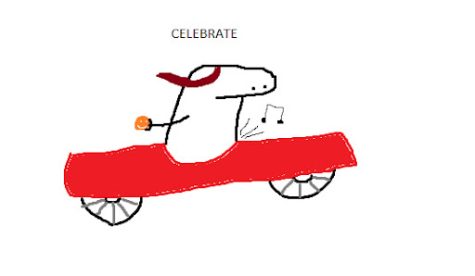Goal-setting for the school year: A how-to guide
Cartoons drawn by Ender Ross.

October 8, 2022
Goals are important, whether they be homework deadlines, the end zone on the sports field, or your own personal objectives. Goals help to keep you focused on the future and provide the opportunity to improve as your own person.
“People tend to get wrapped up in their daily life. It’s easier to stay afloat if you have goals,” said psychology teacher Rebecca Layton, “Long-term or short-term goals makes staying afloat a lot easier.”
While experienced high school students have already learned how to manage their goals and have achieved many of their own, Freshmen might have a harder time.
Goal setting can be difficult, but there are many tips and tricks to help.

Step One: Where to start?
“I do an activity with my students for them to determine what areas of their life where they’re satisfied,” Layton said.
She utilizes a pie chart where students rate their satisfaction with parts of their life, whether it be family, health, romance or any other part.
Using this wheel, it’s easier to determine what aspects of someone’s life that they’re not happy with and plan out short or long-term goals based on that.
This activity is a great starting place for students to determine what focus their goals will have. A student might feel great about their relationship with their parents but not as much with their school work. Then, there’s a great place to dive into.
“[My goals are] generally academic,” said senior Gabriel Naylor, “like trying to get all A’s for a trimester.”

Step Two: Dial In
Once someone has determined what part of their life that they want to focus on, they can start to focus in. This is where you start to determine specifics, something exact and concrete to improve on.
“Where people go really wrong is when they’re trying to make strict changes,” said Layton. “You can’t start being healthy by saying ‘No sugar, no carbs,’’ that’s setting yourself up for failure.”
You have to start small: set an easier goal, and then achieve it before looking to work on too much.
“I typically stick with an idea and push through it before starting another one,” said senior Nina Molitor.

Step 3: Review
As time moves on and you move towards your end goal, it’s always important to review your intentions. Although students might be afraid to change their goals, Layton argues that goals should change.
“They’re your goal posts,” Layton said. “If you thought X, Y, or Z would be useful, but it sucks, try something different.”
The freedom that comes with setting personal goals is that they can change depending on what works or doesn’t work. If one goal ends up being harder than originally thought, or too easy, adjustments can be made.
“If a goal is too easy for me, I just keep going and feel good about myself,” Naylor said.

Step 4: Celebrate
Once a goal has been completed it’s a great time to celebrate. Sometimes you can even set rewards for yourself and these rewards can be motivation for your success.
One great motivator for finishing goals is to have a bribe. A student’s parents might give them $20 for every A they get, or maybe someone might get themselves a donut after working a long shift. For some it could just be the satisfaction.
“I’m not super motivated, but what motivates me is that I’m getting something out of it,” said Molitor. “And that’s all I need to succeed.”
Now’s also a great time to set a new goal! Maybe even several. Goal setting is an ever-changing, ever-evolving progression of someone’s personal interests, and it is an amazing tactic to succeed at anything.












Ender Ross • Oct 12, 2022 at 9:59 am Knight Life Pick
Man, the art on this is truly phenomenal. It captures the surrealist style that the kids are all about these days, and I can definitely see why this person was chosen to make this art. The characters are simple, but they convey a great deal of emotion using their eyes, the turn of their mouth, and the little bandanna they wear. This is the finest graphic I have ever laid eyes upon.
Ender Ross • Nov 4, 2022 at 10:39 am
Almost a month after this article came out, I find myself returning to it. It still captivates my attention, but woe upon me, for it has become a mighty obsession. In my dreams, I see these funny sock looking fellows frozen in ice, eternally standing, and I can only laugh. My wife left me, because I was replacing pictures of our children with these beautiful graphics. But I forgot her. I cannot remember my wedding day, all I know is that it surely was beautiful. All I remember is the link to this article, and the funny photos. My children no longer have names to me. Only obstacles to being able to see this website. I hate them, for they have become my enemy. Help.